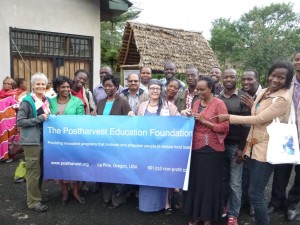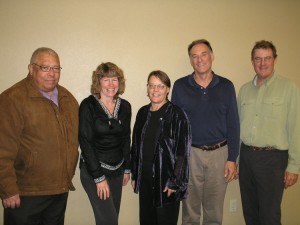Extension specialists and trainers: still the weakest links in our efforts to reduce postharvest losses
By Dr. Lisa Kitinoja, founder of The Postharvest Education Foundation
This post is part of the ADM Institute’s #PreventPHL blog campaign, following up on the First International Congress on Postharvest Loss Prevention. To read more posts in the series, click here.

Postharvest Education Foundation e-learning graduates at the closing workshop in Tanzania / Anne Turner, CRS
It was a pleasure to participate in the First International Congress for Postharvest Loss Prevention, with its theme of developing measurement approaches and intervention strategies for smallholder farmers for postharvest loss reduction. Many experts and young researchers and field practitioners from around the world attended the Congress and shared their ideas and concerns. One of the biggest issues posed by the leaders of the Congress and road mapping exercise: Given that technologies exist to protect harvests, why have they not been adopted worldwide to reduce postharvest losses?
My work for the past 30 years has been as a postharvest training specialist, focused on developing and promoting technologies and extension programs that are suitable for small-scale farmers, traders, processors, and marketers. This means the technologies are relatively simple to use, easy to try, and cost effective from smallholders. Since the 1990s, I have compiled postharvest extension manuals to promote these technologies, written extensively on postharvest extension methods, and worked as a private consultant to provide workshops and hands-on training programs for people in more than 20 countries as part of many different international development projects, but it was very difficult for me to reach more than a few hundred people each year.
In 2011, a few of my close colleagues and I decided to launch The Postharvest Education Foundation with the mission to provide innovative programs that motivate and empower people to reduce postharvest losses and food waste. At that time, there were very few programs in the field of postharvest food loss assessment or reduction, and our purpose was to bring attention to the issues and advocate for more investments in postharvest research and extension.
Since then we have been using a mentor-guided e-learning program to train 20 to 30 young people each year, in topics including postharvest loss assessment methods, appropriate technologies, demonstration design, cost/benefit analyses, and extension program design. Each participant selects their crops of interest from those produced in their country and undergoes a full year of training.

Postharvest Education Foundation (PEF) founding Board of Directors in 2011. From left to right, the late Dr. Adel A. Kader, Dr. Diane M. Barrett, Dr. Lisa Kitinoja, Dr. Devon Zagory, and Dr. Patrick D. Brown / Cathy Kitinoja, PEF
Our primary goal at PEF is to create a cadre of postharvest specialists and trainers in developing countries, who will in turn work with their local extension programs, advisory services, private sector companies, NGOs, international projects and other agencies interested in reducing food losses to provide local postharvest training programs for farmers, traders, food processors and marketers. To date, PEF has trained 110 people as “postharvest specialists” in 27 countries, and they have been providing educational programs that have reached approximately 30,000 local people each year. PEF continues to provide mentoring and technical support for all our graduates, whether they work as employees of government agencies, private companies or as independent consultants. These local postharvest training programs have had positive outcomes regarding technology adoption, reducing food losses and increasing incomes, in part because they are being provided in the local language(s) by professional postharvest specialists and trainers who know the local community and its issues and constraints.
So, to the big question: Given that technologies exist to protect harvests, why have they not been adopted around the world to reduce postharvest losses? One answer is that we simply don’t yet have enough postharvest specialists and local trainers who can bring these postharvest technologies directly to the people who need to learn about them.
Every community on Earth that grows or consumes food needs knowledge, advice, and practical training on the options for handling and storing their food to reduce postharvest losses. We estimate the need for professional postharvest specialists is on the order of thousands. And each specialist will need financial and technical support to be able to do their work.
Ideally, each country should have many postharvest specialists, perhaps one person specializing in each major food crop, and one specialist for each of 10 major postharvest topics (i.e. harvesting, drying/ threshing, packing/packaging, cooling, cold storage, dry storage, pest management, processing, transportation, marketing). These are the professionals who would be responsible for training the nation’s extension agents and advisory service field workers, and for supporting their local training activities. And the needed number of local postharvest trainers and field level extension workers would be even higher — China alone has more than one million agricultural extension agents who work on production, so just imagine if a similar number of extension agents/rural advisory service providers were working on postharvest handling, storage, and processing. Hundreds of thousands of postharvest trainers and extension workers would no doubt be able to begin to reach the hundreds of millions of smallholder farmers, traders, food processors and marketers who currently experience high levels of postharvest losses. Moving forward, all of us will need to promote postharvest capacity building, to help strengthen these weakest links in our efforts to reduce postharvest losses.
The blog entries in this #PreventPHL series are by students and members of our PHL Prevention community of practice. The opinions expressed are those of the individual authors and do not necessarily reflect the position of the ADM Institute. In addition, none of the statements should be considered an endorsement of any person, product, or technique by the ADM Institute.



1 Comment
Thank you Dr Kitinoja and The Postharvest Education Foundation for an “on point” post,
Is it possible to evaluate investment in SSA Extension until it guarantees that specialists and trainers are strong links that can meet SSA grower’s needs?
Land tenure is important to agriculture in North America, Australia and Europe. Some countries invest and develop Land-grant university systems to assess and prioritize grower needs above those of political, religious and private sectors. Land-grant universities that use Extension to be accountable to grower needs are sustained by grower tax dollars. My experience says Canada, Australia and Denmark try to implement Extension without true Land-grant universities. Dedicated Extension enthusiasts can evaluate for example, Extension in Australia.
Much less dedication is required to evaluate Extension in tenure-less SSA. Ruxin (2014) uses Ebola to describe SSA’s political, religious and private sector accountability well in “Step One to Fighting Ebola – Start with Corruption” .
Is the PHL Community of Practice aware of at harvest approaches to support grower tenure in meaningful ways or market interventions that discount protocol and hold financial support accountable?
Without tenure alternatives or incremental steps that suit SSA diversity how will Extension ever provide timely capacity and strong links?
Thank you ADMI for the opportunity to comment.
William Lanier
Add Comment